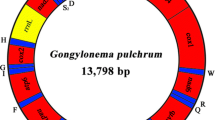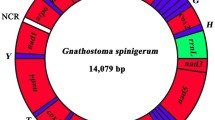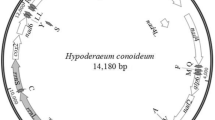Abstract
Hymenolepis nana, commonly known as the dwarf tapeworm, is one of the most common tapeworms of humans and rodents and can cause hymenolepiasis. Although this zoonotic tapeworm is of socio-economic significance in many countries of the world, its genetics, systematics, epidemiology, and biology are poorly understood. In the present study, we sequenced and characterized the complete mitochondrial (mt) genome of H. nana. The mt genome is 13,764 bp in size and encodes 36 genes, including 12 protein-coding genes, 2 ribosomal RNA, and 22 transfer RNA genes. All genes are transcribed in the same direction. The gene order and genome content are completely identical with their congener Hymenolepis diminuta. Phylogenetic analyses based on concatenated amino acid sequences of 12 protein-coding genes by Bayesian inference, Maximum likelihood, and Maximum parsimony showed the division of class Cestoda into two orders, supported the monophylies of both the orders Cyclophyllidea and Pseudophyllidea. Analyses of mt genome sequences also support the monophylies of the three families Taeniidae, Hymenolepididae, and Diphyllobothriidae. This novel mt genome provides a useful genetic marker for studying the molecular epidemiology, systematics, and population genetics of the dwarf tapeworm and should have implications for the diagnosis, prevention, and control of hymenolepiasis in humans.




Similar content being viewed by others
References
Abascal F, Zardoya R, Posada D (2005) ProtTest: selection of best-fit models of protein evolution. Bioinformatics 21:2104–2105
Boore JL (1999) Animal mitochondrial genomes. Nucleic Acids Res 27:1767–1780
Bowles J, McManus DP (1993) NADH dehyddrogrnase 1 gene sequences compared for species and strains of the genus Echinociccus. Int J Parasitol 23:969–972
Guindon S, Gascuel O (2003) A simple, fast, and accurate algorithm to estimate large phylogenies by maximum likelihood. Syst Biol 52:696–704
Jeon HK, Kim KH, Eom KS (2007) Complete sequence of the mitochondrial genome of Taenia saginata: comparison with T. solium and T. asiatica. Parasitol Int 9:243–246
Jia WZ, Yan HB, Guo AJ, Zhu XQ, Wang YC, Shi WG, Chen HT, Zhan F, Zhang SH, Fu BQ, Littlewood DT, Cai XP (2010) Complete mitochondrial genomes of Taenia multiceps, T. hydatigena and T. pisiformis: additional molecular markers for a tapeworm genus of human and animal health significance. BMC Genomics 7:447
Jia YQ, Yan WC, Du SZ, Song JK, Zhao W, Zhao YX, Cheng WY, Zhao GH (2014) Pseudanoplocephala crawfordi is a member of genus Hymenolepis based on phylogenetic analysis using ribosomal and mitochondrial DNA sequences. Mitochondrial DNA. In press
Jiang TJ, Jin ZH, Wu H, Cui CQ (1990) A study on the life-cycle and epidemiology of Pseudanoplocephala crawfordi Baylis, 1927. J Helminthol 64:54–61
Katoh K, Standley DM (2013) MAFFT multiple sequence alignment software version 7: improvements in performance and usability. Mol Biol Evol 30:772–780
Knapp J, Nakao M, Yanagida T, Okamoto M, Saarma U, Lavikainen A, Ito A (2011) Phylogenetic relationships within Echinococcus and Taenia tapeworms (Cestoda: Taeniidae): an inference from nuclear protein-coding genes. Mol Phylogenet Evol 61:628–638
Liu GH, Lin RQ, Li MW, Liu W, Liu Y, Yuan ZG, Song HQ, Zhao GH, Zhang KX, Zhu XQ (2011) The complete mitochondrial genomes of three cestode species of Taenia infecting animals and humans. Mol Biol Rep 4:2249–2256
Liu GH, Li C, Li JY, Zhou DH, Xiong RC, Lin RQ, Zou FC, Zhu XQ (2012) Characterization of the complete mitochondrial genome sequence of Spirometra erinaceieuropaei (Cestoda: Diphyllobothriidae) from China. Int J Biol Sci 8:640–649
Liu GH, Shao R, Li JY, Zhou DH, Li H, Zhu XQ (2013) The complete mitochondrial genomes of three parasitic nematodes of birds: a unique gene order and insights into nematode phylogeny. BMC Genomics 14:414
Liu GH, Zhao L, Song HQ, Zhao GH, Cai JZ, Zhao Q, Zhu XQ (2014a) Chabertia erschowi (Nematoda) is a distinct species based on nuclear ribosomal DNA sequences and mitochondrial DNA sequences. Parasit Vectors 7:44
Liu GH, Yan HB, Otranto D, Wang XY, Zhao GH, Jia WZ, Zhu XQ (2014b) Dicrocoelium chinensis and Dicrocoelium dendriticum (Trematoda: Digenea) are distinct lancet fluke species based on mitochondrial and nuclear ribosomal DNA sequences. Mol Phylogenet Evol 10:325–331
Liu GH, Li S, Zou FC, Wang CR, Zhu XQ (2016) The complete mitochondrial genome of rabbit pinworm Passalurus ambiguus: genome characterization and phylogenetic analysis. Parasitol Res. 2015 Oct 16. In press
Lowe TM, Eddy SR (1997) tRNAscan-SE: a program for improved detection of transfer RNA genes in genomic sequence. Nucleic Acids Res 25:955–964
Macnish MG, Morgan-Ryan UM, Monis PT, Behnke JM, Thompson RC (2002) molecular phylogeny of nuclear and mitochondrial sequences in Hymenolepis nana (Cestoda) supports the existence of a cryptic species. Parasitology 125:567–575
Makarikov AA, Mel’nikova YA, Tkach VV (2015) Description and phylogenetic affinities of two new species of Nomadolepis (Eucestoda, Hymenolepididae) from Eastern Palearctic. Parasitol Int 64:453–463
Mbaya H, Magambo J, Njenga S, Zeyhle E, Mbae C, Mulinge E, Wassermann M, Kern P, Romig T (2014) Echinococcus spp. in central Kenya: a different story. Parasitol Res 113:3789–3794
Nakao M, Lavikainen A, Iwaki T, Haukisalmi V, Konyaev S, Oku Y, Okamoto M, Ito A (2013) Molecular phylogeny of the genus Taenia (Cestoda: Taeniidae): proposals for the resurrection of Hydatigera Lamarck, 1816 and the creation of a new genus Versteria. Int J Parasitol 43:427–437
Okamoto M, Agatsuma T, Kurosaw T, Ito A (1997) Phylogenetic relationships of three hymenolepidid species inferred from nuclear ribosomal and mitochondrial DNA sequences. Parasitology 115:661–666
Olson PD, Tkach VV (2005) Advances and trends in the molecular systematics of the parasitic Platyhelminthes. Adv Parasitol 60:165–243
Palmeirim M, Bordes F, Chaisiri K, Siribat P, Ribas A, Morand S (2014) Helminth parasite species richness in rodents from Southeast Asia: role of host species and habitat. Parasitol Res 113:3713–3726
Ronquist F, Huelsenbeck JP (2003) MrBayes 3: Bayesian phylogenetic inference under mixed models. Bioinformatics 19:1572–1574
Sirivichayakul C, Radomyos P, Praevanit R, Pojjaroen-Anant C, Wisetsing P (2000) Hymenolepis nana infection in Thai children. J Med Assoc Thai 9:1035–1038
Swofford DL (2002) PAUP: Phylogenetic Analysis Using Parsimony, version 4.0b. Illinois Natural History Survey, Champaign
Talavera G, Castresana J (2007) Improvement of phylogenies after removing divergent and ambiguously aligned blocks from protein sequence alignments. Syst Biol 56:564–577
Tamura K, Peterson D, Peterson N, Stecher G, Nei M, Kumar S (2011) MEGA 5: molecular evolutionary genetics analysis using maximum likelihood, evolutionary distance, and maximum parsimony methods. Mol Biol Evol 28:2731–2739
Tao M, You CP, Zhao RR, Liu SJ, Zhang ZH, Zhang C, Liu Y (2014) Animal mitochondria: evolution, function, and disease. Curr Mol Med 14:115–124
Thompson RC (2015) Neglected zoonotic helminths: Hymenolepis nana, Echinococcus canadensis and Ancylostoma ceylanicum. Clin Microbiol Infect 21:426–432
Von Nickisch-Rosenegk M, Brown WM, Boore JL (2001) Complete sequence of the mitochondrial genome of the tapeworm Hymenolepis diminuta: gene arrangements indicate that Platyhelminths are Eutrochozoans. Mol Biol Evol 5:721–730
Wang M (2002) Veterinary parasitology, 3rd edn. Agriculture Press, Beijing
Widmer VC, Georgiev BB, Mariaux J (2013) A new genus of the family Hymenolepididae (Cestoda) from Sephanoides sephaniodes (Apodiformes, Trochilidae) in Northern Patagonia (Chile). Acta Parasitol 58:105–111
Willcocks B, McAuliffe GN, Baird RW (2015) Dwarf tapeworm (Hymenolepis nana): characteristics in the Northern Territory 2002–2013. J Paediatr Child Health 51:982–987
Wolstenholme DR (1992) Animal mitochondrial DNA, structure and evolution. Int Rev Cytol 141:173–216
Yamasaki H, Ohmae H, Kuramochi T (2012) Complete mitochondrial genomes of Diplogonoporus balaenopterae and Diplogonoporus grandis (Cestoda: Diphyllobothriidae) and clarification of their taxonomic relationships. Parasitol Int 6:260–266
Zhao GH, Wang HB, Jia YQ, Zhao W, Hu XF, Yu SK, Liu GH (2015) The complete mitochondrial genome of Pseudanoplocephala crawfordi and a comparison with closely related cestode species. J Helminthol. In press
Acknowledgments
This work was supported by the International Science & Technology Cooperation Program of China (Grant No. 2013DFA31840) and the Science Fund for Creative Research Groups of Gansu Province (Grant No. 1210RJIA006).
Author information
Authors and Affiliations
Corresponding authors
Rights and permissions
About this article
Cite this article
Cheng, T., Liu, GH., Song, HQ. et al. The complete mitochondrial genome of the dwarf tapeworm Hymenolepis nana—a neglected zoonotic helminth. Parasitol Res 115, 1253–1262 (2016). https://doi.org/10.1007/s00436-015-4862-8
Received:
Accepted:
Published:
Issue Date:
DOI: https://doi.org/10.1007/s00436-015-4862-8




